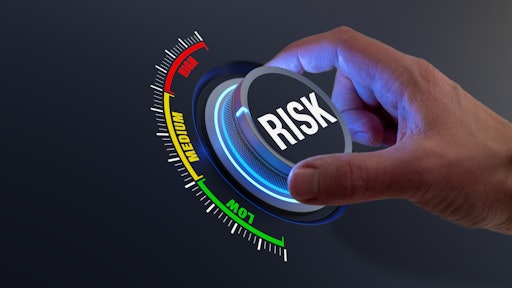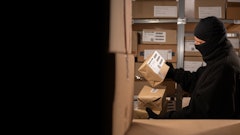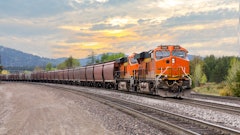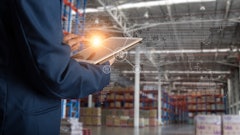
Over the years, executing a risk mitigation plan has transformed from something that’s nice to have to something that every company must have, at all times, in all facets of the organization.
From the influx of cargo theft, cybersecurity threats, food safety and driver shortage to geopolitical tensions, strikes from rail/dock workers, natural disasters and more, even the smallest gap can pose serious threat to people, product and plant.
Liken it to the blind leading the blind, getting lost in a maze or driving while blindfolded.
Not being able to see ahead and predict and plan accordingly is what sometimes plagues many of today’s supply chain companies.
What’s more, the shifting business landscape forces freight shippers, brokers and carriers to shift tactics and accelerate the use of market data and artificial intelligence (AI)-driven analytics, according to DAT Freight & Analytics.
That’s why mitigating supply chain threats is of utmost importance heading into 2024.
In fact, resiliency is now table-stakes for the supply chain, as the next disruption is just around the corner, says Adheer Bahulkar, global supply chain lead for consumer goods and services, Accenture. [CLICK HERE to read an exclusive interview with Bahulkar].
There are many other challenges facing cold food chains, ranging from weather shocks and staff shortages to inefficiencies in transportation and storage, to name a few, according to Bahulkar.
“For example, we know a large proportion of food produced for human consumption is lost due to the lack of effective refrigeration,” Bahulkar adds. “Manufacturers are constantly dealing with the ripple effects of supply chain disruptions such as changes in consumption, adverse weather events and changing regulations and trade policies. It’s easy to see why this could leave them feeling they’re in constant ‘response mode’ to keep pace. We are also seeing shifts in food consumption, with many consumers shifting preferences toward convenience and ready-to-eat food. This increases the demand for cold chains.”
And, while macro factors such as cargo theft, war, and driver shortages add complexity to cold chain logistics, the persistent challenge of inventory loss and spoilage arguably poses the greatest threat, says Himanshu Mehrotra, VP of product management at FourKites. [CLICK HERE to read an exclusive interview with Mehrotra].
“A report by the Food and Agriculture Organization (FAO) indicates that approximately 14% of the world's food is lost from harvest to retail, largely owing to inadequate cold chain facilities and poor temperature management during transit. For businesses, especially those operating with slim margins, the financial repercussions of such losses are profound,” adds Mehrotra. “But the risk extends beyond mere inventory loss. Companies also face the possibility of shipment rejection. If a shipment fails to meet stringent temperature compliance standards, it’s often rejected unless the shipper can convincingly demonstrate that the correct temperature was maintained throughout transit. The implications of a rejected shipment go beyond the immediate financial loss. It causes a ripple effect in the supply chain, leading to delayed delivery schedules and adversely impacting customer relations.”
Increased cost of capital also poses underlying challenge behind many of the threats impacting the cold food supply chain, says Peter Cadigan, consumer products senior analyst with RSM US LLP. [CLICK HERE to read an exclusive interview with Cadigan].
“The dearth of cold and frozen storage infrastructure in the U.S. presented challenges dating back to before the pandemic. When demand surged in 2020 and 2021, we saw developers start to build cold storage facilities on spec in a meaningful way for the first time. Now, with interest rates changing the math on those investments, there could be a slowdown of similar investments,” he adds. “The issue touches on labor challenges as well. Many of the lower wage jobs in the cold storage supply chain simply aren’t attractive. We’ve seen the industry raise wages to attract and retain workers, but we’ve seen real benefits for business that have invested in automation and robotics to offset their reliance on those jobs and get more out of their higher waged labor force. With capital costs on the rise those types of investments have become more expensive.”
In its right, food safety still remains a paramount concern, “as any break in the cold chain can lead to spoilage or contamination of both raw materials and finished products, posing health risks and strong financial consequences,” says Eric Linxwiler, SVP at TradeBeyond. “Geopolitical tensions and wars, like the conflict in Ukraine, disrupt global trade routes and create supply shortages. Looming strikes from rail and dock workers can cause severe bottlenecks, delaying shipments and leading to spoilage. Finally, natural disasters, amplified by climate change, create unpredictable crop shortages and pose unpredictable risks to transportation and storage infrastructure.” [CLICK HERE to read an exclusive interview with Linxwiler].
“Multiple disruptions in the supply chain experienced over the last few years, such as the shortage of raw materials due to political, social, or weather disruptions, have compelled companies to test alternative suppliers with untested cold chain performance,” says Linxwiler. “Delays in shipment, whether of raw materials or finished goods, increase the potential of the cold chain being broken. There are multiple examples of refrigerated containers being on standby at ports with inadequate cold chain capabilities, ruining the products.”
From a digital perspective, ransomware ranks as a big threat to the cold food chain. In fact, ransomware attackers extorted at least $449.1 million in the first half of 2023 alone, according to the Department of Homeland Security.
“Cyber risk can be mitigated by having robust backups and recovery plans and by using cloud services. Also, there’s a shortage of cybersecurity talent. Technology schools and universities aren’t producing enough to meet the ever-increasing demand, and what few there are get snapped up by bigger organizations or government entities. So, organizations should also look to more managed services for cybersecurity and need to upgrade to modern and secure software, specifically their ERP software,” says Kevin Beasley, CIO, VAI. [CLICK HERE to read an exclusive interview with Beasley].
But, supply chain threats aside, instability in the supply chain, such as geopolitical sanctions, natural disasters, inflation and more will impact and influence the way companies can mitigate supply chain threats.
Collectively, these factors contribute to a complex set of cold chain challenges.
“With so many dynamic variables seemingly out of their control, companies need the tools to help them simplify cargo management and strengthen the performance of their supply chains. This starts by ensuring that every link in their perishable cold chain is equipped with a proper monitoring toolset and adhering to their quality assurance (QA) best practices,” says Amy Childress, VP of monitoring, cargo for Copeland. [CLICK HERE to read an exclusive interview with Childress].
Rise in cargo theft prompts action
According to multiple sources, the average value of cargo stolen during reported events in 2023 was $214,104, equivalent to an estimated $223 million in cargo across 1,778 reported theft incidents.
BSI’s Supply Chain Risk Insights Report 2023 reveals several key factors behind the increases in supply chain disruptions and in the theft of food and beverage commodities.
“These include rising food prices contributing to the increased demand, natural disasters and climate change, which has had a significant impact on the availability of crops, geopolitical incidents including the war in Ukraine, trade relationships between major economies like the U.S. and China, and the frequency of cyberattacks on the food industry and its supply chain,” says Neil Coole, director food and retail, BSI.
The report also shows that last year, food and beverage were the top commodities stolen in transit.
“One of the main reasons behind this trend is that food and beverage products are always in high demand, and inflationary factors have resulted in sharp price increases over the past two years,” says Coole. “In a living supply chain, access to these goods in transit can be relatively easy in comparison to higher-value commodities (e.g., fuel, electronics, medical supplies and machine parts). Additionally, food and beverage commodities tend to have little to no tracking devices and anti-theft technologies.”
According to a recent report from CargoNet, Q2 of 2023 saw a 57% increase in cargo theft compared to Q2 of 2022. Documented strategic cargo theft events increased 430% year-over-year and theft of a loaded conveyance such as a full trailer increased 4% year-over-year. These kinds of thefts were most common in California, Texas, Florida, Georgia, and Illinois. CargoNet also recorded a significant increase in the "other" category, which combines several categories of reports like identity theft complaints, hostage loads, late shipment complaints, and other kinds of criminal intelligence records.
“This unprecedented increase largely can be attributed to shipment misdirection attacks, a strategic form of cargo theft in which thieves and criminal networks steal the identities of motor carriers and logistics brokers. After assuming their victims’ identities, thieves can then obtain their freight, misdirect it from the intended receiver, and steal the cargo,” says Childress. “This emerging scheme makes cargo tracking a mandatory element in companies’ security strategies.”
But, while rising cargo theft is often attributed to inflation and rising prices, the larger root causes perhaps are quite structural, says Bahulkar.
“For example, the rise in e-commerce has meant that more cargo is spending time in warehouses and in transit. Other disruptions and bottlenecks, such as staff shortages or delays in transportation can also lead to more inventories being stuck in transit or sitting for longer in warehouses. This raises the risk of theft, not to mention lost sales,” he adds.
What’s more is, thieves have always targeted high-value, high-profile goods. Since the onset of the pandemic in 2020, the FBI observed an uptick in strategic cargo theft and fictitious freight cases. To combat this increase in activity, a Truckstop report details the seven Major Theft Task Forces located throughout the United States trained to identify and mitigate cargo theft cases. The most common types of theft they track and investigate are traditional theft of a truck-tractor semi-trailer, identity theft, fictitious pickups, hijacking, pilferage and warehouse burglaries.
“Freight’s high volume and mobility over land, sea, and air make cargo theft a crime of opportunity. Other factors contributing to cargo theft desirability include the cash-based nature of the business, lenient punishments if caught, and multiple methods used to commit the crime (fictitious pickups, identity theft, straight cargo theft, pilferage, etc.). It’s also incredibly easy to disguise the scam as a legitimate trucking company and hide in plain sight,” according to Truckstop.
Rethinking supply chains
A study from Container xChange reveals 82% of industry professionals acknowledge the importance of technology for resilience in 2024, with predictive analysis and forecasting tools taking center stage.
And, while some factors are predictable in the sense that there is always a threat for hurricanes, earthquakes and natural phenomena, others are not predictable. Therefore, having a risk management strategy in place helps soften the blow.
“There are a number of tools and processes that exist to help with improving machine usage and throughput. But very few of the systems in the areas of manufacturing execution really focus on the empowerment of the line worker. Having systems and processes in place to have the workforce informed and communicating better throughout the plant can seriously improve efficiencies and production as well as protecting the integrity of the cold chain. Building a skilled and adaptable workforce is essential. Employees should be trained in risk management, crisis response, and the use of relevant technologies to ensure a proactive and efficient response to supply chain disruptions,” says Stephen Dombroski, director, consumer markets, QAD, Inc. “Leveraging advanced technologies like artificial intelligence, machine learning, and data analytics can enhance supply chain visibility. Real-time monitoring and predictive analytics can help companies identify potential disruptions early on, allowing for proactive mitigation strategies.” [CLICK HERE to read an exclusive interview with Dombroski].
The influx in technology is what continues to encourage companies to rethink their supply chains. This could relate to the adoption of emerging technologies and putting in place specific parameters to track, trace, measure and plan accordingly.
“The future of supply chain management largely depends on the adoption of technologies in automation, IoT, AI and more in order to bring sustainability, visibility, and reliability to operations,” says Bahulkar. “Along with alternative sources of supply and right-shoring, a combination of full value chain visibility combined with predictive analytics and read-and-respond capabilities are key for supply chain to mitigate the impact of disruptions. We can expect resiliency in supply chain to become a critical advantage for companies enabling them to not only ensure business continuity but systematically gain market share as consumers increasingly rely on them through all disruptions.”
Rethinking supply chains could also mean utilizing analytics and solutions in different ways to better allow for pre-emptive action.
“New playbooks are constantly being written and with the emergence of generative AI, we will see new processes be established that five years ago, weren’t even dreamed of. Critical to these strategies are deep, data-driven insights into the supply chain supported by subject matter experts who are embracing change,” says Mehrotra. “For instance, predictive analytics can be utilized to foresee bottlenecks caused by natural disasters, allowing for preemptive action such as rerouting shipments or adjusting inventory levels before the storm even hits. Another example is using real-time data to monitor supplier performance, enabling quick responses to delays or quality issues. This approach also facilitates strategic diversification of suppliers, reducing dependence on any single source and thereby mitigating risks associated with supplier reliability. Having insight upstream and downstream can also help companies optimize inventory levels, striking a balance between minimizing holding costs and ensuring sufficient stock to handle demand fluctuations.”
Future of safe supply chains
Labor disruptions are also substantially higher this year, up 136%, according to Resilinc data. This includes company and site-level strikes, national strikes, layoffs and labor protests, among others. But what does this mean for the future of cold food supply chains?
“Labor disruptions and more importantly sustained labor shortages are expected to have a significant impact on future design of supply chains,” says Bahulkar. “Demographic as well as socio-economic trends are resulting in a shrinking workforce ready for skilled labor in manufacturing and distribution and a high turnover becoming commonplace for many manufacturers. What this means for future supply chains is two things: Rising wages as companies compete to fill the gaps in their workforce in the near to mid-term; and a gradual but steady shift to automation on the shop floors over the mid- to long-term.”
Worker strikes and labor shortages continue to have significant impacts on the future of the food supply chain. But, it’s how the cold food supply chain will respond that makes or breaks the disruptions.
“There are opportunities and solutions available to these organizations, including creating a more inclusive culture that prioritizes its people, putting health, safety and mental well-being at the core of organizational culture, investing in people, upskilling the workforce and creating a more balanced work/life arrangement to mitigate against staff burnout, improve the industry’s reputation and help to attract future talent,” Coole says.
For many organizations, the future of a safer supply chain lies in the hands of leveraging automation.
“Firstly, we see automation creating exciting careers in supply chain for talented people, and that builds in labor loyalty through better career prospects, so there’s less volatility. Secondly, we see automation by its very nature reducing the risk of labor disruptions to operations – a risk that is inherent in traditional manual warehouses,” says Jonas Swarttouw, EVP and chairman of NewCold North America. “So, you insulate your organization from labor shocks in the warehouse by automating key bottlenecks in your operations, enabling your associates to upskill and develop and take on elevated roles, while you drive efficiency, accuracy, and resilience with smart automation to deliver always-on high-level service.” [CLICK HERE to read an exclusive interview with Swarttouw].
To stay ahead of the disruptions, food and beverage shippers, cold chain distribution providers, refrigerated carriers and others in the chain must invest in understanding partners' health, forecasts, and operating models, says Mehrotra.
“This includes details such as financial health, capacity commitments and constraints, facility dwell, customer requirements, claims, and what happens as the bullwhip effect occurs. The leaders in cold chain have invested heavily in a strong horizontal supply chain with the right strategic partners,” he adds.
And, of course, timing is everything.
“When you are talking about the operations of a supply chain, there are many factors that go into managing them. It starts with planning; demand (forecasting), distribution, production, procurement planning functions. You need to have a plan in place. However, executing that plan is a different story. You can have the most accurate product forecast, the best distribution plan, the best capacity plan and have all your materials and ingredients ready to go. When dealing with a cold supply chain, timing is everything because it revolves around perishability,” Dombroski says.
In general, small- and medium-sized businesses in the food industry will need to expand their digital footprints in response to increased regulation in 2024, says Beasley.
“In particular, the sector will increasingly adopt blockchain and IoT to comply with regulations that call for end-to-end traceability. This will require having advanced modern ERP software with food industry-specific capabilities necessary to deal with these cutting-edge technologies,” he adds. “These and other emerging technologies will generate an enormous amount of data that can be used to train AI models. Beyond 2024, we may see an explosion of AI deployment in small and medium-sized businesses in this sector.”
At the end of the day though, a unique threat to one company’s logistics operations may be urgent and need to be mitigated immediately, while the same threat to another company’s logistics operation may be trivial, says Ron Greene, VP of business development at Overhaul. [CLICK HERE to read an exclusive interview with Greene].
“All logistics operations are similar with unique attributes; the threats to cold food chains and associated risks follow this same structure. For example, a food company operating in Mexico and Los Angeles need to take a proactive approach to mitigate theft, while the same company’s operations in Nebraska will likely not have to mitigate this specific risk. Companies need to assess risks continually and make decisions on the appropriate mitigation approach as threats can change in real-time,” Greene says.






























